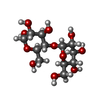+ Open data
Open data
- Basic information
Basic information
| Entry | Database: PDB / ID: 7rxc | ||||||||||||||||||||||||||||||||||||
|---|---|---|---|---|---|---|---|---|---|---|---|---|---|---|---|---|---|---|---|---|---|---|---|---|---|---|---|---|---|---|---|---|---|---|---|---|---|
| Title | CryoEM structure of KDELR with Legobody | ||||||||||||||||||||||||||||||||||||
 Components Components |
| ||||||||||||||||||||||||||||||||||||
 Keywords Keywords | STRUCTURAL PROTEIN / protein A / maltose-binding protein / Fab / nanobody | ||||||||||||||||||||||||||||||||||||
| Function / homology |  Function and homology information Function and homology informationKDEL sequence binding / ER retention sequence binding / COPI-dependent Golgi-to-ER retrograde traffic / COPI-coated vesicle membrane / protein retention in ER lumen / COPI-mediated anterograde transport / maintenance of protein localization in endoplasmic reticulum / cis-Golgi network / retrograde vesicle-mediated transport, Golgi to endoplasmic reticulum / IgG binding ...KDEL sequence binding / ER retention sequence binding / COPI-dependent Golgi-to-ER retrograde traffic / COPI-coated vesicle membrane / protein retention in ER lumen / COPI-mediated anterograde transport / maintenance of protein localization in endoplasmic reticulum / cis-Golgi network / retrograde vesicle-mediated transport, Golgi to endoplasmic reticulum / IgG binding / carbohydrate transmembrane transporter activity / protein transport / periplasmic space / Golgi membrane / endoplasmic reticulum membrane / endoplasmic reticulum / extracellular region / membrane Similarity search - Function | ||||||||||||||||||||||||||||||||||||
| Biological species |      Streptococcus sp. (bacteria) Streptococcus sp. (bacteria) | ||||||||||||||||||||||||||||||||||||
| Method | ELECTRON MICROSCOPY / single particle reconstruction / cryo EM / Resolution: 3.2 Å | ||||||||||||||||||||||||||||||||||||
 Authors Authors | Wu, X.D. / Rapoport, T.A. | ||||||||||||||||||||||||||||||||||||
| Funding support |  United States, 1items United States, 1items
| ||||||||||||||||||||||||||||||||||||
 Citation Citation |  Journal: Proc Natl Acad Sci U S A / Year: 2021 Journal: Proc Natl Acad Sci U S A / Year: 2021Title: Cryo-EM structure determination of small proteins by nanobody-binding scaffolds (Legobodies). Authors: Xudong Wu / Tom A Rapoport /  Abstract: We describe a general method that allows structure determination of small proteins by single-particle cryo-electron microscopy (cryo-EM). The method is based on the availability of a target-binding ...We describe a general method that allows structure determination of small proteins by single-particle cryo-electron microscopy (cryo-EM). The method is based on the availability of a target-binding nanobody, which is then rigidly attached to two scaffolds: 1) a Fab fragment of an antibody directed against the nanobody and 2) a nanobody-binding protein A fragment fused to maltose binding protein and Fab-binding domains. The overall ensemble of ∼120 kDa, called Legobody, does not perturb the nanobody-target interaction, is easily recognizable in EM images due to its unique shape, and facilitates particle alignment in cryo-EM image processing. The utility of the method is demonstrated for the KDEL receptor, a 23-kDa membrane protein, resulting in a map at 3.2-Å overall resolution with density sufficient for de novo model building, and for the 22-kDa receptor-binding domain (RBD) of SARS-CoV-2 spike protein, resulting in a map at 3.6-Å resolution that allows analysis of the binding interface to the nanobody. The Legobody approach thus overcomes the current size limitations of cryo-EM analysis. | ||||||||||||||||||||||||||||||||||||
| History |
|
- Structure visualization
Structure visualization
| Movie |
 Movie viewer Movie viewer |
|---|---|
| Structure viewer | Molecule:  Molmil Molmil Jmol/JSmol Jmol/JSmol |
- Downloads & links
Downloads & links
- Download
Download
| PDBx/mmCIF format |  7rxc.cif.gz 7rxc.cif.gz | 226.2 KB | Display |  PDBx/mmCIF format PDBx/mmCIF format |
|---|---|---|---|---|
| PDB format |  pdb7rxc.ent.gz pdb7rxc.ent.gz | 173.5 KB | Display |  PDB format PDB format |
| PDBx/mmJSON format |  7rxc.json.gz 7rxc.json.gz | Tree view |  PDBx/mmJSON format PDBx/mmJSON format | |
| Others |  Other downloads Other downloads |
-Validation report
| Summary document |  7rxc_validation.pdf.gz 7rxc_validation.pdf.gz | 1 MB | Display |  wwPDB validaton report wwPDB validaton report |
|---|---|---|---|---|
| Full document |  7rxc_full_validation.pdf.gz 7rxc_full_validation.pdf.gz | 1.1 MB | Display | |
| Data in XML |  7rxc_validation.xml.gz 7rxc_validation.xml.gz | 36.5 KB | Display | |
| Data in CIF |  7rxc_validation.cif.gz 7rxc_validation.cif.gz | 57 KB | Display | |
| Arichive directory |  https://data.pdbj.org/pub/pdb/validation_reports/rx/7rxc https://data.pdbj.org/pub/pdb/validation_reports/rx/7rxc ftp://data.pdbj.org/pub/pdb/validation_reports/rx/7rxc ftp://data.pdbj.org/pub/pdb/validation_reports/rx/7rxc | HTTPS FTP |
-Related structure data
| Related structure data |  24728MC  7r9dC  7rxdC C: citing same article ( M: map data used to model this data |
|---|---|
| Similar structure data |
- Links
Links
- Assembly
Assembly
| Deposited unit | 
|
|---|---|
| 1 |
|
- Components
Components
-Antibody , 4 types, 4 molecules HLNB
| #1: Antibody | Mass: 25252.217 Da / Num. of mol.: 1 Source method: isolated from a genetically manipulated source Source: (gene. exp.)   Homo sapiens (human) Homo sapiens (human) |
|---|---|
| #2: Antibody | Mass: 24095.852 Da / Num. of mol.: 1 Source method: isolated from a genetically manipulated source Source: (gene. exp.)   Homo sapiens (human) Homo sapiens (human) |
| #3: Antibody | Mass: 14698.260 Da / Num. of mol.: 1 Source method: isolated from a genetically manipulated source Source: (gene. exp.)   |
| #4: Antibody | Mass: 59233.246 Da / Num. of mol.: 1 Source method: isolated from a genetically manipulated source Source: (gene. exp.)    Streptococcus sp. (bacteria) Streptococcus sp. (bacteria)Gene: DAH37_23060, spa, spg / Production host:  References: UniProt: A0A4Z0THX4, UniProt: P99134, UniProt: P06654 |
-Protein / Sugars / Non-polymers , 3 types, 6 molecules K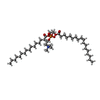

| #5: Protein | Mass: 30083.959 Da / Num. of mol.: 1 Source method: isolated from a genetically manipulated source Source: (gene. exp.)   |
|---|---|
| #6: Polysaccharide | alpha-D-glucopyranose-(1-4)-alpha-D-glucopyranose |
| #7: Chemical | ChemComp-POV / ( |
-Details
| Has ligand of interest | N |
|---|---|
| Has protein modification | Y |
-Experimental details
-Experiment
| Experiment | Method: ELECTRON MICROSCOPY |
|---|---|
| EM experiment | Aggregation state: PARTICLE / 3D reconstruction method: single particle reconstruction |
- Sample preparation
Sample preparation
| Component | Name: The complex of KDELR with Legobody / Type: COMPLEX / Entity ID: #1-#5 / Source: MULTIPLE SOURCES |
|---|---|
| Molecular weight | Value: 0.15 MDa / Experimental value: NO |
| Buffer solution | pH: 7.4 |
| Specimen | Embedding applied: NO / Shadowing applied: NO / Staining applied: NO / Vitrification applied: YES |
| Vitrification | Cryogen name: ETHANE |
- Electron microscopy imaging
Electron microscopy imaging
| Experimental equipment |  Model: Titan Krios / Image courtesy: FEI Company |
|---|---|
| Microscopy | Model: FEI TITAN KRIOS |
| Electron gun | Electron source:  FIELD EMISSION GUN / Accelerating voltage: 300 kV / Illumination mode: FLOOD BEAM FIELD EMISSION GUN / Accelerating voltage: 300 kV / Illumination mode: FLOOD BEAM |
| Electron lens | Mode: BRIGHT FIELD |
| Image recording | Electron dose: 51.44 e/Å2 / Film or detector model: GATAN K3 (6k x 4k) |
- Processing
Processing
| Software | Name: PHENIX / Version: 1.19.1_4122: / Classification: refinement | ||||||||||||||||||||||||
|---|---|---|---|---|---|---|---|---|---|---|---|---|---|---|---|---|---|---|---|---|---|---|---|---|---|
| EM software | Name: PHENIX / Category: model refinement | ||||||||||||||||||||||||
| CTF correction | Type: PHASE FLIPPING AND AMPLITUDE CORRECTION | ||||||||||||||||||||||||
| 3D reconstruction | Resolution: 3.2 Å / Resolution method: FSC 0.143 CUT-OFF / Num. of particles: 246878 / Symmetry type: POINT | ||||||||||||||||||||||||
| Refine LS restraints |
|
 Movie
Movie Controller
Controller




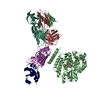

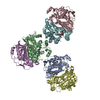

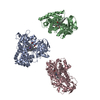
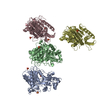
 PDBj
PDBj










